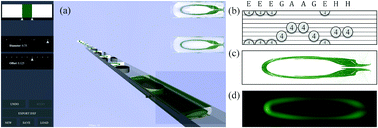Micropillar sequence designs for fundamental inertial flow transformations
Abstract
The ability to control the shape of a flow in a passive microfluidic device enables potential applications in chemical reaction control, particle separation, and complex material fabrication. Recent work has demonstrated the concept of sculpting fluid streams in a microchannel using a set of pillars or other structures that individually deform a flow in a predictable pre-computed manner. These individual pillars are then placed in a defined sequence within the channel to yield the composition of the individual flow deformations – and ultimately complex user-defined flow shapes. In this way, an elegant mathematical operation can yield the final flow shape for a sequence without an experiment or additional numerical simulation. Although these approaches allow for programming complex flow shapes without understanding the detailed fluid mechanics, the design of an arbitrary flow shape of interest remains difficult, requiring significant design iteration. The development of intuitive basic operations (i.e. higher-level functions that consist of combinations of obstacles) that act on the flow field to create a basis for more complex transformations would be useful in systematically achieving a desired flow shape. Here, we show eight transformations that could serve as a partial basis for more complex transformations. We initially used in-house, freely available custom software (uFlow), which allowed us to arrive at these transformations that include making a fluid stream concave and convex, tilting, stretching, splitting, adding a vertex, shifting, and encapsulating another flow stream. The pillar sequences corresponding to these transformations were subsequently fabricated and optically analyzed using confocal imaging – yielding close agreement with uFlow-predicted shapes. We performed topological analysis on each transformation, characterizing potential sequences leading to these outputs and trends associated with changing diameter and placement of the pillars. We classify operations into four sets of sequence-building concatenations: stacking, recursion, mirroring, and shaping. The developed basis should help in the design of microfluidic systems that have a phenomenal variety of applications, such as optofluidic lensing, enhanced heat transfer, or new polymer fiber design.


 Please wait while we load your content...
Please wait while we load your content...